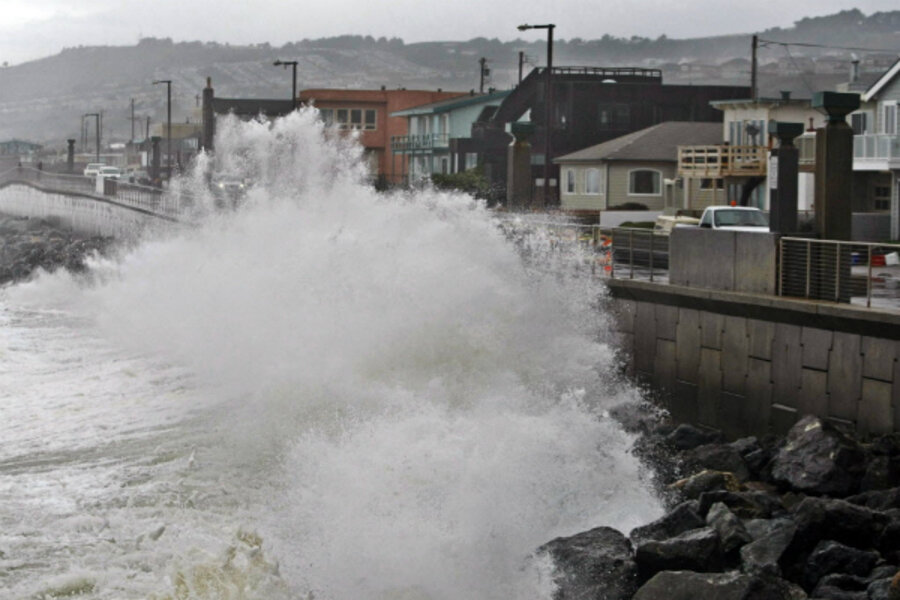West Coast sea levels: New report estimates greater rise by 2100
Loading...
If greenhouse-gas emissions continue unabated, the expected additional warming could raise sea levels by up to four or five feet all along the US West Coast by 2100, according to an analysis released Friday by the National Research Council (NRC).
Beyond any real estate permanently inundated, such an increase would bring some $100 billion worth of facilities that currently are high and dry into a new 100-year flood plain, according to previous studies that assumed a comparable increase in sea levels. Those facilities include power plants, airports and seaports, and other big-ticket pieces of infrastructure.
The council, the research arm of the National Academy of Sciences in Washington, produced the report at the request of the state of California.
The study is expected to become a common frame of reference that coastal communities can use to plan their adaptation measures, says Heather Cooley, co-director of the water program for the Pacific Institute, based in Oakland, Calif. The institute focuses on environmental issues and on the sustainable use of resources.
The NRC's estimates are higher than some previous estimates because they take advantage of more recent research than earlier estimates – notably those estimates published in 2007 by the United Nations-sponsored Intergovernmental Panel on Climate Change (IPCC).
The NRC's estimates are the latest but not the final word on the subject, Ms. Cooley cautions. As techniques for measuring and analyzing sea-level data improve, and as climate models improve, the numbers are likely to change. The biggest uncertainty: how quickly humans move to curb greenhouse-gas emissions – most notably carbon dioxide – in terms of fossil-fuel and land-use changes.
For now, however, "communities can begin to use this as part of their adaptation planning," she says.
The report underscores that several factors combine to determine sea-level rise in any one location. Local wind and ocean-circulation patterns, and even the West Coast's shifting crustal plates, which generate earthquakes and raise volcanoes, can play a role. A magnitude 8 quake along the Cascadia Subduction Zone off the Pacific Northwest, for instance, could significantly change a coastal community's height above sea level within seconds, according to the study. Intense El Niño events can boost sea levels in winter by as much as a foot. Changes to the mass of icecaps in Alaska, Greenland, and Antarctica alter sea levels on the West Coast by changing the distribution of mass on the planet, inducing regional changes in Earth's gravitational field.
Rising sea levels triggered by global warming are superimposed on these natural factors. Warming by itself affects the oceans in several ways. The ocean expands from heating alone. Melting land-based ice contributes. And human-induced changes to river flows also have an effect: Dams tend to reduce rivers' input of water to the oceans, while heavy use of aquifers can increase the flows to the sea.
Between the 2007 IPCC report and the NRC study, new studies have shown thermal expansion to have played a smaller role in sea-level rise than the IPCC estimated. But melting ice's role has grown. The latest estimates attribute 65 percent of the rise in global average sea levels between 1993 and 2008 to melting ice. Ground water and water stored in reservoirs in effect cancel each other out.
The NRC estimates that by 2030, global average sea levels could rise between three and nine inches over 2000 levels, range from six inches to two feet by 2050, and from 19 to 55 inches by 2100. The IPCC's upper estimate from 2007 projects as much as a 23-inch rise by 2100.
For the West Coast, the NRC's figures by century's end are much higher than the IPCC's 2007 projection as well, although different regions take different paths. The report notes that depending on the rate of sea-level rise, north of California's Cape Mendocino, sea levels along the coast could fall roughly a tenth of an inch or more during the first half of the century, largely because of the impact of subduction along the Cascadia Subduction Zone.
As the Pacific Plate slides beneath the Juan de Fuca Plate, it puts upward pressure on the crust to the east. Although the NRC's projections show considerable sea-level rise north of the cape during the latter half of the century, it remains somewhat less than elsewhere along the coast because of this tectonic process. By 2100, the NRC projects an average rise of between four inches and 56 inches north of the cape, and between 17 inches and 66 inches south of it.
The broad ranges in the NCR's estimate reflect in no small part uncertainties in the future rate of glacier and icecap melting, as well as in changes to land height, among other issues. The committee acknowledges that the uncertainties grow larger the further out they try to project.
Regardless of which end of the estimates proves the more likely as time passes, averages don't tell the whole story, adds Robert Dalrymple, a civil engineer at the Johns Hopkins University in Baltimore who chaired the NRC committee conducting the study.
"As the average sea level rises," he said in a prepared statement, "the number and duration of extreme storm surges and high waves are expected to escalate," increasing the risk of the destruction of wetlands, the erosion of beaches and coastal bluffs, and flooding.







